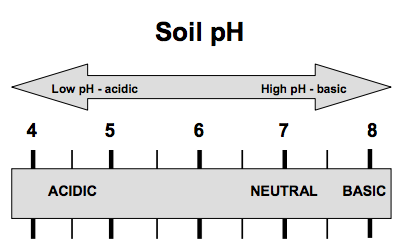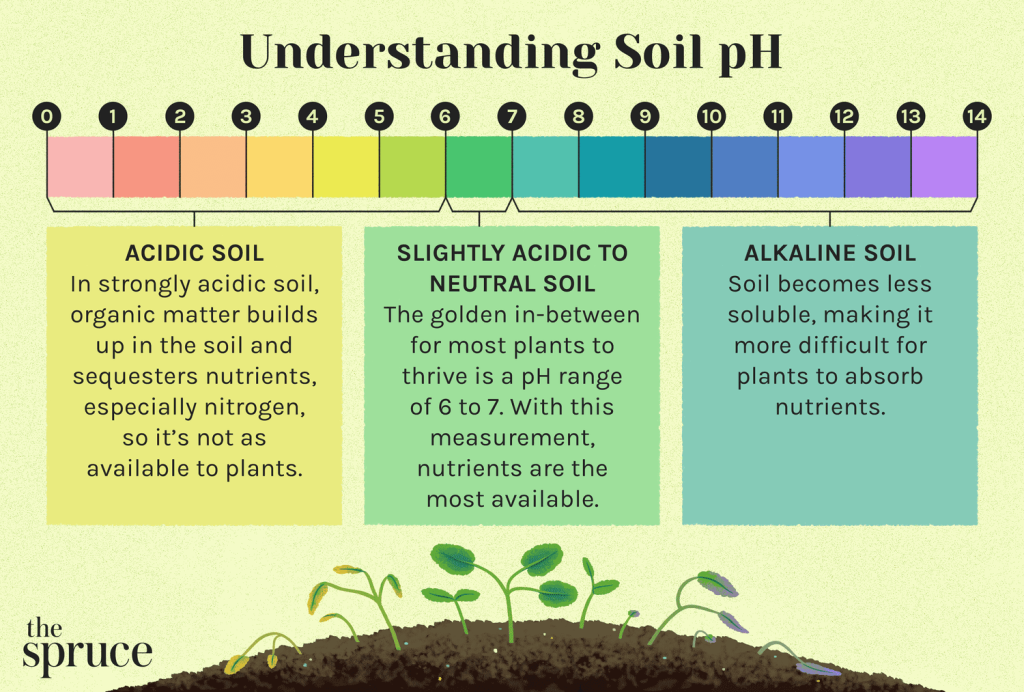Are your plants looking a little under the weather? The secret to thriving gardens and lush landscapes might just lie beneath your feet.
Understanding soil pH is crucial for any gardener or plant enthusiast. It can mean the difference between vibrant blooms and wilted leaves. We’ll dive into the fascinating world of soil pH, revealing its importance and how it directly impacts the health of your plants.
You’ll discover practical tips on how to measure and adjust soil pH, ensuring your garden is a thriving oasis. Ready to unlock the secrets of healthy soil? Let’s dig in!
Basics Of Soil Ph
Soil pH measures acidity or alkalinity, impacting plant growth and nutrient availability. Adjusting pH helps optimize soil health. Lime raises pH, while sulfur lowers it. Understanding soil pH ensures better gardening results and healthier plants.
Understanding the basics of soil pH is essential for any gardener or farmer aiming to optimize plant growth. Soil pH is a measure of how acidic or alkaline the soil is, and it can have a significant impact on nutrient availability, plant health, and overall garden success. By grasping the fundamentals, you can make informed decisions about how to manage your soil for better plant performance.What Is Soil Ph?
Soil pH is expressed on a scale from 0 to 14, with 7 being neutral. Values below 7 indicate acidic soil, while those above 7 indicate alkaline soil. Many plants thrive in a slightly acidic to neutral range, generally between 6 and 7.How Soil Ph Affects Plant Growth
The pH level of soil affects the availability of essential nutrients. For example, iron and manganese become less available in alkaline soils, which can lead to deficiencies. On the other hand, acidic soils can make toxic elements like aluminum more available, harming plant roots.Testing Your Soil Ph
Testing your soil pH is the first step in understanding its current state. Simple pH test kits are available at garden centers and provide quick results. For more precise readings, consider sending a sample to a local agricultural extension service. If your soil is too acidic, adding lime can help raise the pH. This improves nutrient availability and fosters a healthier plant environment. Conversely, if your soil is too alkaline, incorporating organic matter like peat moss or sulfur can help lower the pH.Personal Experience With Soil Ph
I once struggled with yellowing leaves on my tomato plants, only to find that my soil was too alkaline. After testing, I adjusted the pH by adding peat moss, and soon, my tomatoes perked up. It was a simple fix that taught me the value of understanding soil pH.Why Soil Ph Matters To You
You might wonder if soil pH is really that important. Consider this: if your plants aren’t thriving despite regular care, pH could be the missing piece. Testing and adjusting soil pH can be a game changer for your garden’s health and productivity.Next Steps For Improving Soil Ph
Start by testing your soil to know where you stand. Then, take action based on the results. Whether you need to raise or lower your soil pH, making these adjustments can lead to lush, productive plants.
Impact On Plant Health
Understanding soil pH is crucial for plant health. It affects nutrient absorption and overall growth. Adjusting pH ensures plants thrive by providing the right environment.
Understanding soil pH is crucial for your garden’s health. It’s not just a number; it directly affects how well your plants grow. Soil pH influences nutrient availability, plant growth, and even the microorganisms in your soil. Let’s dive into how soil pH impacts plant health and what you can do about it. ###How Soil Ph Affects Nutrient Availability
Soil pH determines how easily plants can access nutrients. Each nutrient has an optimal pH range where it’s most available. If your soil’s pH is too high or too low, plants struggle to absorb what they need. Picture this: you’ve fertilized your garden, but your plants still look weak. The culprit might be pH imbalance. Check your soil’s pH to ensure your efforts aren’t wasted. ###Influence On Plant Growth
A mismatch in soil pH can stunt your plant’s growth. Acidic soil might limit your vegetables’ size, while alkaline soil can yellow your plant leaves. I once planted tomatoes in soil that was too acidic. They grew, but the yield was disappointing. Adjusting the pH improved both growth and harvest. Are your plants not thriving as expected? Consider their soil pH as a possible reason. ###Impact On Soil Microorganisms
Soil microorganisms play a vital role in breaking down organic matter. They thrive best in neutral pH conditions. An imbalanced pH can reduce their activity, affecting nutrient cycling. Imagine a team working under poor conditions; they’re less efficient. Similarly, your soil’s ecosystem suffers when pH is off. Keeping pH balanced supports these tiny helpers in maintaining soil health. ###Signs Your Soil Ph Might Be Off
Your plants can show signs if the pH isn’t right. Yellow leaves, poor growth, or unexpected wilting can be indicators. A simple soil test can provide answers. Have you noticed these issues in your garden? It might be time to check your soil’s pH and take action. ###Practical Steps To Adjust Soil Ph
Adjusting soil pH isn’t as daunting as it sounds. To raise pH, you can add lime. To lower it, sulfur is often used. Before making changes, test your soil to know exactly what it needs. Regular monitoring can help maintain the right balance. Have you adjusted your soil’s pH before? Share your experience and how it affected your plants. Understanding and managing soil pH is a game-changer for plant health. It ensures that your plants have the best chance to thrive. Take charge of your soil’s pH and watch your garden flourish.Adjusting Soil Ph
Understanding soil pH is crucial for healthy plant growth. It affects nutrient availability and microbial activity. Adjusting soil pH involves adding lime to raise it or sulfur to lower it, ensuring optimal conditions for your garden.
Adjusting soil pH is crucial for healthy plant growth. Whether you’re nurturing a vegetable garden or cultivating vibrant flowers, understanding how to modify the soil’s acidity or alkalinity can make a significant difference. Have you ever wondered why your tomatoes aren’t thriving despite your best efforts? It might just be the soil pH! Let’s dive into how you can tweak this vital aspect to create the perfect growing environment.Understanding Your Current Soil Ph
Before making any adjustments, it’s essential to know the current pH level of your soil. You can easily test your soil using a home testing kit available at gardening stores. These kits provide a quick snapshot of whether your soil is acidic, neutral, or alkaline. A simple test can guide your next steps in adjusting the pH. Once you know the baseline, you can proceed with confidence.Choosing The Right Amendments
Depending on your soil’s pH, you might need to add certain materials to correct it. If your soil is too acidic, consider adding lime. Lime is a common solution that raises pH levels, making your soil less acidic and more suitable for a range of plants. On the other hand, if your soil is too alkaline, sulfur might be your best friend. Sulfur lowers pH levels, creating an environment where acid-loving plants like blueberries can thrive.Applying Amendments Effectively
It’s not just about choosing the right amendment; it’s also about applying it correctly. Spread lime or sulfur evenly over the soil surface, then work it into the top few inches using a rake. This ensures the amendment mixes well with the existing soil. Consider timing as well. Applying amendments in fall allows them to integrate with the soil over winter, ready for spring planting.Monitoring Changes
After adjusting the pH, keep an eye on your soil’s reaction. Regular testing will help you track changes and ensure you’re on the right path. It might take a few weeks or even months for amendments to show their full effect. Are you curious about how your plants respond? Observing your garden’s growth can reveal a lot about how well your soil adjustments are working.Personal Experience And Tips
I once struggled with growing strawberries until I realized my soil was too alkaline. After testing, I added sulfur and saw a remarkable change in their growth. It taught me the importance of understanding soil pH and how it affects plant health. Have you ever had a similar experience? Adjusting your soil pH can truly transform your gardening results. Keep experimenting and testing. Your plants will thank you! Engage with your soil; it’s alive and dynamic. What adjustments will you try next?
Tools For Monitoring Ph Levels
Understanding soil pH is vital for healthy plant growth. The right tools make monitoring easier. They help you keep your soil balanced. With these tools, you can quickly check soil acidity or alkalinity. This knowledge helps you make informed decisions for your garden.
Ph Test Strips
pH test strips are simple and affordable. They provide quick results. Just dip a strip in a soil-water mixture. Compare the color change to a chart. This method is easy and requires no technical expertise.
Digital Ph Meters
Digital pH meters offer precise readings. They are user-friendly and reliable. Insert the probe into the soil and get instant results. Regular calibration ensures their accuracy.
Soil Ph Testing Kits
Soil pH testing kits are comprehensive. They include all necessary items. Mix soil with a special solution. The resulting color indicates pH levels. These kits often provide detailed instructions.
Smart Soil Sensors
Smart soil sensors connect to apps. They offer real-time monitoring. These devices track pH and other metrics. They are ideal for tech-savvy gardeners.
Professional Soil Testing Services
Professional services offer detailed analyses. Send a sample to a lab. They provide comprehensive reports. This option gives expert insights into soil health.

Conclusion
Understanding soil pH is crucial for healthy plants. It influences nutrient absorption and growth. Adjusting soil pH helps optimize plant health. Test your soil regularly. Use lime to raise pH or sulfur to lower it. Follow instructions carefully for best results.
Balance is key to thriving gardens. Experiment and observe changes over time. Plants show signs when pH is off. Learn and adapt for better gardening success. With patience, your garden will flourish. Happy gardening and fruitful harvests await!



